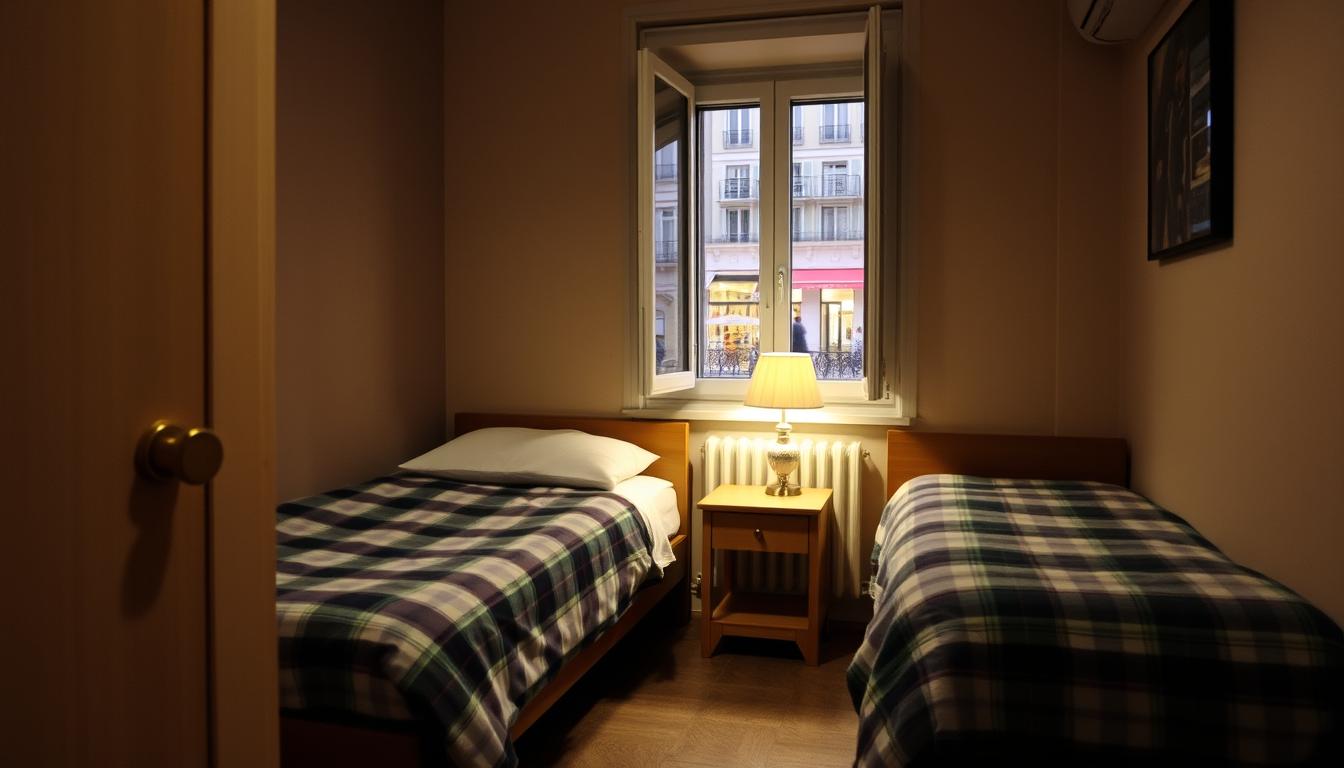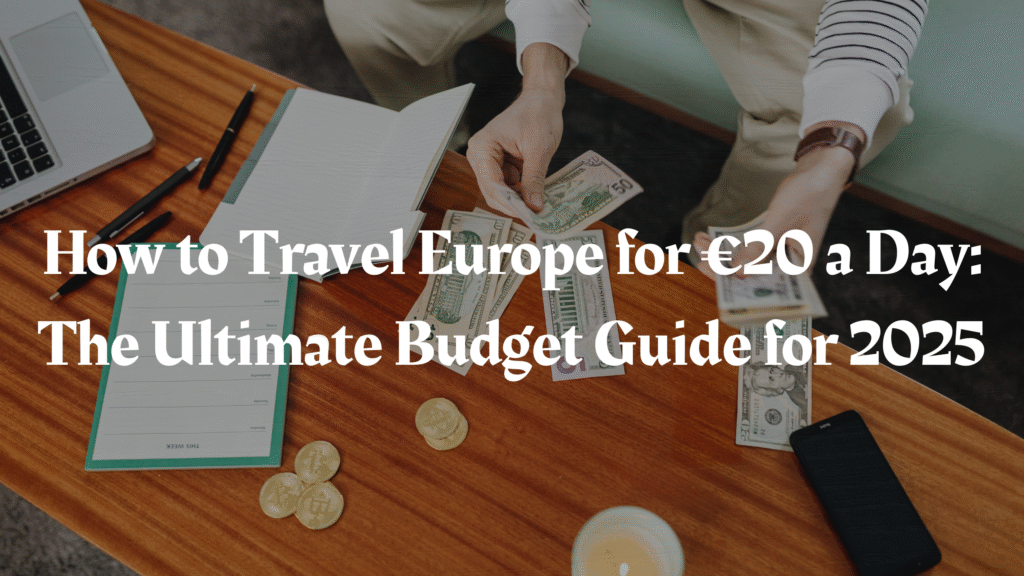Exploring Europe doesn’t have to break the bank. With some planning, you can experience the rich history, vibrant culture, and breathtaking landscapes of Europe without overspending. Budget travel in Europe is more accessible than ever, with affordable accommodations, delicious street food, and free attractions.

Imagine wandering through the ancient streets of Rome, visiting iconic landmarks like the Eiffel Tower, or enjoying the scenic beauty of the Greek Islands, all within your budget. This guide will walk you through the essentials of affordable travel in Europe, providing tips on cheap accommodations, transportation, and activities.
Key Takeaways
- Discover affordable destinations in Europe
- Learn tips for saving on accommodations and transportation
- Explore free and low-cost activities and attractions
- Understand how to plan a budget-friendly trip to Europe
- Get insights into budget travel hacks for Europe
The €20 Challenge: Is It Really Possible?
The idea of exploring Europe on a mere €20 per day may seem daunting, but it’s a reality for many travelers. This challenge isn’t just about cutting costs; it’s about immersing yourself in the local culture, meeting fellow travelers, and discovering hidden gems that luxury travel often overlooks.
What This Budget Covers
When we talk about traveling Europe on €20 a day, we’re referring to a budget that covers the essentials: accommodation, food, transportation, and activities. This means opting for budget hostels, preparing your own meals, using public transport, and seeking out free or low-cost attractions.
Setting Realistic Expectations
While €20 a day is achievable, it’s crucial to understand that some days will be more expensive than others. Factors like city-specific costs, seasonal variations, and unexpected expenses can impact your budget. Being flexible and prepared for these variations is key.
The Mindset of Ultra-Budget Travel
Embracing ultra-budget travel requires a specific mindset: being open to new experiences, willing to adapt plans, and not being afraid to try local, affordable options. It’s about valuing experiences over material comforts and finding joy in the journey, not just the destination.
By adopting this mindset and understanding what your budget covers, you can successfully navigate Europe on €20 a day, creating memorable experiences without breaking the bank.
Planning Your Budget European Adventure
Embarking on a budget European adventure requires meticulous planning to ensure a cost-effective journey. With the right strategies, travelers can enjoy a rich European experience without overspending.
Download this FREE budget planner PDF to effortlessly track all your travel expenses and stay in control of your journey.
Best Times to Visit for Maximum Savings
Visiting Europe during the off-season (usually November to March) can lead to significant savings on accommodations and tourist attractions. Consider traveling during the shoulder season (April to May or September to October) for a balance between comfortable weather and lower prices.
Creating a Budget-Friendly Itinerary
To create a budget-friendly itinerary, prioritize free or low-cost activities such as visiting local markets, exploring public parks, and walking tours. Researching and listing down affordable options in advance can help in sticking to the budget.
Essential Apps and Websites for Budget Travel
Utilizing the right apps and websites can significantly reduce travel costs. Some essential tools include:
- Budgeting apps like Trail Wallet or YNAB (You Need a Budget)
- Travel deal websites such as Skyscanner or Google Flights for finding cheap flights
- Accommodation booking platforms like Hostelworld or Booking.com for affordable stays
Planning Timeline: 6 Months to Departure
Starting your planning six months in advance allows for better deals on flights and accommodations. Key milestones include:
- Researching destinations and creating a preliminary itinerary
- Booking flights and major accommodations
- Finalizing the daily itinerary and budget breakdown
By following these planning steps, travelers can enjoy a fulfilling European adventure on a budget of €20 a day.
How to Travel Europe on a Budget: Transportation Hacks
For many travelers, the thought of traversing Europe on a budget can be daunting, but with the right transportation strategies, it’s entirely achievable. Europe offers a complex network of transportation options, and understanding how to navigate them affordably is key to a successful budget trip.
Budget Airlines and Flight Booking Strategies
Budget airlines have revolutionized air travel in Europe, offering cheap flights that can be a significant cost saver. To make the most of budget airlines, it’s crucial to book in advance, be flexible with your travel dates, and consider alternative airports. Using flight comparison websites like Skyscanner or Google Flights can help you find the best deals.
Rail Passes vs. Individual Tickets: What’s Cheaper?
Europe’s rail network is extensive and efficient. When it comes to rail travel, deciding between a rail pass and individual tickets depends on your itinerary. For extensive travel, a rail pass might be more economical, while individual tickets are better for sporadic or short journeys. Websites like Rail Europe can help you navigate your options.
Bus Travel: The Ultimate Money Saver
Bus travel is another affordable option in Europe, with companies like FlixBus and Eurolines offering extensive networks. While it may take longer, bus travel is significantly cheaper and can be a good choice for shorter distances or when budget is a priority.
Hitchhiking and Ridesharing Safety Tips
For the more adventurous, hitchhiking and ridesharing can be viable options. Always use reputable platforms like BlaBlaCar for ridesharing, and exercise caution when hitchhiking, especially for solo travelers.
City Transportation Without Tourist Passes
Navigating cities without buying expensive tourist passes is possible. Many cities offer affordable public transportation options, and walking or cycling are great ways to explore. Consider purchasing a local SIM card or using public Wi-Fi to navigate using transit apps.
Sleep Cheap: Accommodation for Under €10 a Day
Europe offers a wide range of budget-friendly accommodation options for the savvy traveler. Whether you’re looking to save money or simply enjoy the local culture, there’s something for everyone.
Hostel Strategies and Booking Tips
Hostels are a staple of budget travel, offering dorms and private rooms at affordable prices. To get the best deals, consider booking in advance through platforms like Hostelworld or Booking.com. Look for hostels that offer free amenities like Wi-Fi, laundry, or breakfast to maximize your savings.
| Hostel | Price per Night (€) | Amenities |
|---|---|---|
| Meininger Berlin | 15 | Free Wi-Fi, Bar, Kitchen |
| Generator Paris | 18 | Free Breakfast, Lounge, Laundry |
Couchsurfing and Hospitality Exchanges
Couchsurfing is a fantastic way to experience local culture while saving on accommodation costs. By staying with locals, you not only save money but also gain insights into the community that you might not get from a traditional hostel.
« Couchsurfing has been a game-changer for my travel experiences. It’s not just about saving money; it’s about connecting with people and understanding their culture. »
— A seasoned Couchsurfer
Work Exchange Programs: WWOOF, Workaway, and HelpX
Work exchange programs like WWOOF, Workaway, and HelpX offer free accommodation in exchange for work. These programs are a great way to immerse yourself in local communities while keeping costs low.

Wild Camping and Budget Campsites
For those who enjoy the outdoors, wild camping or staying at budget campsites can be a cost-effective option. Always check local regulations regarding wild camping to avoid any issues.
Last-Minute Accommodation Deals
For last-minute deals, apps like Last Minute Travel or websites like Hostelbookers can offer significant discounts on unsold rooms.
By utilizing these strategies, travelers can significantly reduce their accommodation expenses, making their European adventure even more affordable.
Eating Well on €5-7 Daily: Food Strategies
Eating affordably in Europe doesn’t mean sacrificing flavor or missing out on local cuisine. With a few simple strategies, you can enjoy delicious meals while keeping your daily food costs between €5-7.
Grocery Shopping Like a Local
One of the most effective ways to save on food is by grocery shopping like a local. Visit local markets or supermarkets instead of relying on touristy areas. For instance, discount supermarkets like Aldi or Lidl offer affordable and quality products. You can pick up fresh produce, bread, and cheese at a fraction of the cost of dining out.
Street Food Gems Across Europe
Street food is a staple in many European cities, offering a delicious and affordable way to experience local cuisine. From kebabs in Berlin to crepes in Paris, street food vendors provide a quick and tasty meal on the go.
Cook-Your-Own Hostel Meals
Many hostels offer kitchen facilities where you can prepare your own meals. Cooking your own food not only saves money but also allows you to experiment with local ingredients. Consider buying ingredients for a simple pasta dish or stir-fry.
Water and Drink Savings
Staying hydrated is important, but buying bottled water can add up. Refill your bottle at public water fountains or ask for tap water at restaurants. For other drinks, look for affordable local options like beer or wine when dining out.
Finding Affordable Local Restaurants
When you do choose to eat out, look for restaurants off the beaten path. Local eateries often offer more authentic and affordable meals than tourist-oriented restaurants. Ask locals for recommendations or check out online reviews to find the best budget-friendly spots.
Free and Nearly-Free Activities in Major European Cities
Uncover the best free and nearly-free activities Europe has to offer. Major European cities are treasure troves of culture, history, and entertainment, much of which can be experienced without breaking the bank.
Museum Free Days and Cultural Passes
Many European museums offer free admission on certain days of the week or month. For instance, the Louvre in Paris is free on the first Saturday of every month. Researching these opportunities can save you a significant amount.
Self-Guided Walking Tours
Explore the historic streets of Europe with self-guided walking tours. These tours allow you to discover hidden gems at your own pace. Cities like Rome and Barcelona have numerous walking trails that highlight their rich history.

Parks, Beaches, and Natural Attractions
Europe is home to some of the world’s most beautiful parks and beaches. From the Luxembourg Gardens in Paris to the beaches of Barcelona, these natural attractions are often free or low-cost.
Free Events and Festivals
Europeans love to celebrate, and many festivals are free to attend. Whether it’s a street performance in Amsterdam or a cultural festival in Berlin, there’s always something happening.
Student and Youth Discounts
Even if you’re not a student, many attractions offer youth discounts. Always ask if there’s a reduced rate available.
| City | Free Activity | Cost |
|---|---|---|
| Paris | Louvre on first Saturday | Free |
| Rome | Colosseum guided tour (with Roma Pass) | €12 (pass) |
| Barcelona | Park Güell | €10 |
« The world is a book, and those who do not travel read only one page. » – Saint Augustine
By taking advantage of these free and nearly-free activities, you can enjoy all that Europe has to offer without overspending.
Top 10 Budget-Friendly European Destinations for 2025
Europe in 2025 is a haven for budget-conscious travelers, with numerous cities offering great value for money. As we explore the continent’s most affordable gems, you’ll discover that traveling on a budget doesn’t mean compromising on experience.
Eastern European Gems: Budapest, Krakow, and Sofia
Eastern Europe is a treasure trove of budget-friendly destinations. Budapest, for instance, offers thermal baths, stunning architecture, and a vibrant nightlife, all at an affordable price. Krakow boasts a well-preserved medieval center and a lively cultural scene, while Sofia combines ancient history with modern amenities, all without breaking the bank.
Affordable Mediterranean Spots: Porto, Valencia, and Thessaloniki
The Mediterranean region is not just for luxury travelers. Porto in Portugal offers beautiful riverside views and affordable Port wine, while Valencia in Spain is known for its City of Arts and Sciences and delicious seafood, all at reasonable prices. Thessaloniki in Greece provides a rich historical experience and vibrant nightlife on a budget.
| City | Average Daily Cost | Must-See Attractions |
|---|---|---|
| Budapest | €15-€25 | Parliament Building, Széchenyi Thermal Bath |
| Krakow | €10-€20 | Wawel Castle, Main Market Square |
| Sofia | €8-€18 | Alexander Nevsky Cathedral, Vitosha Mountain |
Western European Cities That Won’t Break the Bank
While Western Europe is often associated with higher costs, there are still budget-friendly options. Cities like Porto and Lisbon in Portugal offer affordable accommodation and dining, along with rich cultural experiences.
Off-the-Beaten-Path Budget Destinations
For the more adventurous, destinations like Plovdiv in Bulgaria and Lviv in Ukraine offer unique cultural experiences at very low costs. These cities are rich in history and provide an authentic travel experience without the hefty price tag.
In conclusion, Europe in 2025 is full of budget-friendly destinations waiting to be explored. Whether you’re drawn to the historical richness of Eastern Europe or the sun-kissed Mediterranean coast, there’s something for every budget-conscious traveler.
Money Matters: Banking, Currency, and Avoiding Fees
To make the most of your European adventure, understanding money matters is key. Effective financial management can significantly impact your travel experience, allowing you to enjoy more of what Europe has to offer without breaking the bank.
Best Cards for International Travel
Choosing the right credit or debit card can save you a substantial amount on foreign transaction fees. Look for cards that offer no foreign transaction fees, such as the Chase Sapphire Preferred or Revolut. These cards can help you avoid unnecessary charges on your purchases abroad.
Currency Exchange Tips
When exchanging currency, avoid exchanging money at airports or tourist areas, as they often offer poor exchange rates. Instead, use ATMs to withdraw local currency or load a prepaid currency card. Be aware of your bank’s foreign ATM fees to minimize costs.
Budgeting Apps for Travelers
Utilizing budgeting apps can help track your expenses and stay within your daily budget. Apps like Trail Wallet or YNAB (You Need a Budget) allow you to monitor your spending in real-time, making it easier to adjust your budget as needed.
Emergency Funds and Safety Nets
Having an emergency fund is crucial when traveling. Consider setting aside a portion of your budget for unexpected expenses. Additionally, having a backup plan, such as a secondary credit card or a stash of cash, can provide peace of mind.
| Financial Tool | Benefit | Recommendation |
|---|---|---|
| No Foreign Transaction Fee Cards | Saves on transaction fees | Chase Sapphire Preferred, Revolut |
| Budgeting Apps | Tracks expenses | Trail Wallet, YNAB |
| Emergency Funds | Covers unexpected expenses | Allocate 10% of travel budget |
Staying Safe While Traveling Ultra-Budget
Traveling on a tight budget doesn’t mean you have to compromise on safety. With some planning and research, you can enjoy a secure and enjoyable journey.
Budget-Friendly Travel Insurance Options
Look for affordable travel insurance that covers essential risks. Consider companies that offer flexible plans and competitive pricing.
| Insurance Provider | Cost | Coverage |
|---|---|---|
| Provider A | $20 | Basic |
| Provider B | $50 | Comprehensive |
Health Precautions on a Budget
Take necessary health precautions without breaking the bank. Research free or low-cost health resources at your destination.
Securing Your Belongings
Use affordable lockers or safety bags to secure your belongings. Be mindful of your surroundings, especially in crowded areas.
Communication Options Without Breaking the Bank
Use cost-effective communication options like local SIM cards or messaging apps. Stay in touch with family and friends without incurring high roaming charges.
Conclusion: Your €20-a-Day European Adventure Awaits
Embarking on a budget European adventure is more than just a travel choice; it’s a lifestyle. With careful planning, smart decisions, and a bit of flexibility, you can explore the rich history, vibrant culture, and breathtaking landscapes of Europe without breaking the bank.
From budget-friendly destinations like Budapest and Porto to affordable transportation options and delicious street food, this guide has equipped you with the tools to make your €20-a-day European adventure a reality. As you plan your trip, remember that Europe travel conclusion isn’t just about reaching your destination; it’s about the experiences you have along the way.
So pack your bags, grab your backpack, and get ready to immerse yourself in the beauty of Europe. With the right mindset and a bit of creativity, your budget European adventure is just around the corner.
FAQ
What is the best time to visit Europe on a budget?
The best time to visit Europe on a budget is during the shoulder season, typically April-May or September-October, when prices are lower and the weather is still pleasant.
How can I find affordable accommodation in Europe?
You can find affordable accommodation in Europe by booking hostels, using Couchsurfing, or opting for work exchange programs like WWOOF, Workaway, or HelpX.
What are some budget-friendly transportation options in Europe?
Budget-friendly transportation options in Europe include budget airlines, rail passes, bus travel, and city transportation without tourist passes.
How can I eat well on a tight budget in Europe?
You can eat well on a tight budget in Europe by grocery shopping like a local, trying street food, cooking in hostels, and finding affordable local restaurants.
What are some free or nearly-free activities to do in major European cities?
Some free or nearly-free activities to do in major European cities include visiting museums on free days, taking self-guided walking tours, exploring parks and natural attractions, and attending free events and festivals.
How can I stay safe while traveling ultra-budget in Europe?
To stay safe while traveling ultra-budget in Europe, consider budget-friendly travel insurance options, take health precautions, secure your belongings, and use cost-effective communication options.
What are the best budget-friendly European destinations for 2025?
Some of the best budget-friendly European destinations for 2025 include Eastern European cities like Budapest and Krakow, Mediterranean spots like Porto and Valencia, and Western European cities that offer affordable options.
How can I manage my finances effectively while traveling in Europe?
To manage your finances effectively while traveling in Europe, use the best cards for international travel, follow currency exchange tips, utilize budgeting apps, and maintain emergency funds.
Can I really travel Europe on a €20 daily budget?
Yes, it is possible to travel Europe on a €20 daily budget by being mindful of your expenses, choosing affordable options, and planning ahead.
What mindset is required for ultra-budget travel in Europe?
The mindset required for ultra-budget travel in Europe involves being flexible, resourceful, and open to new experiences, as well as being willing to adapt to changing circumstances.



